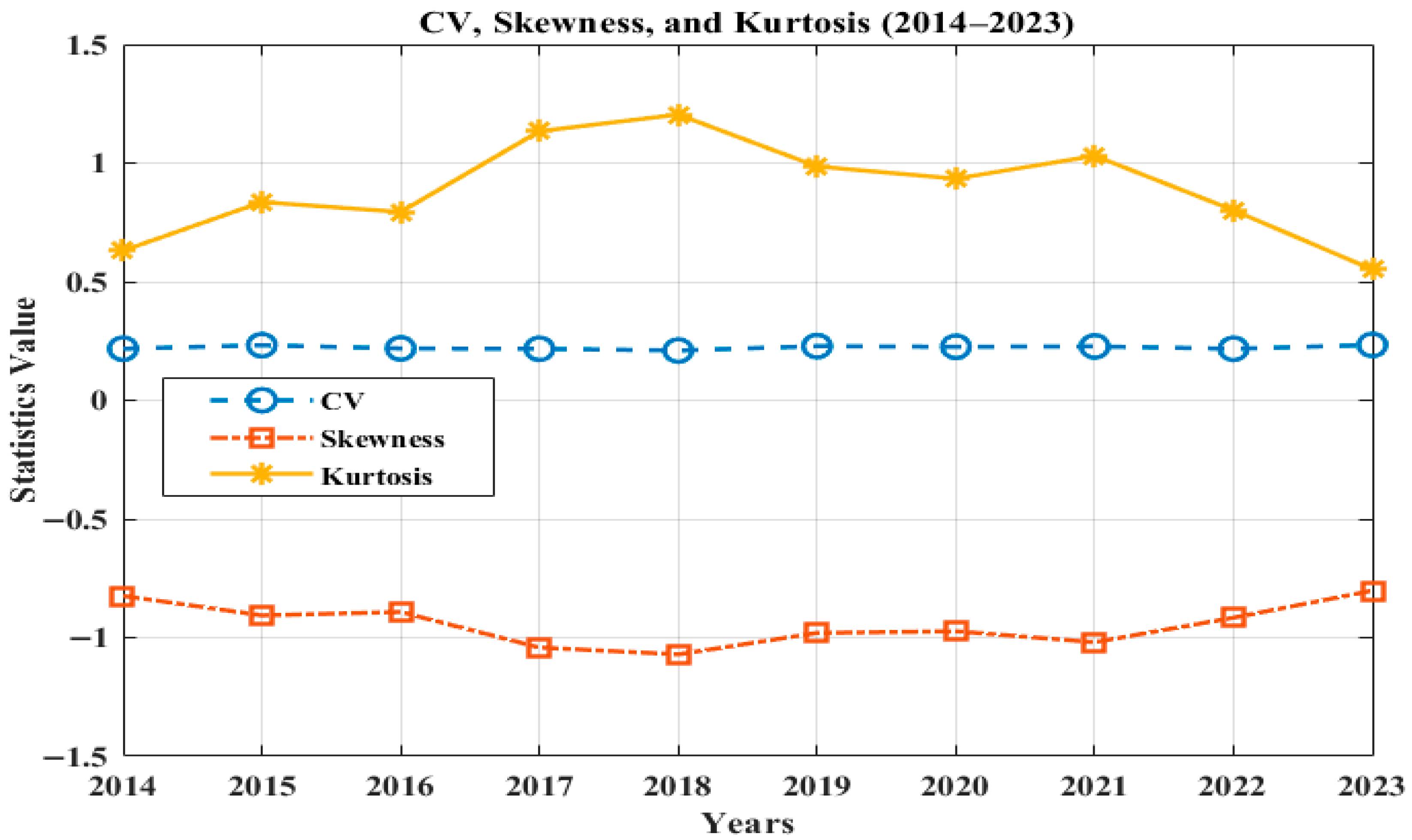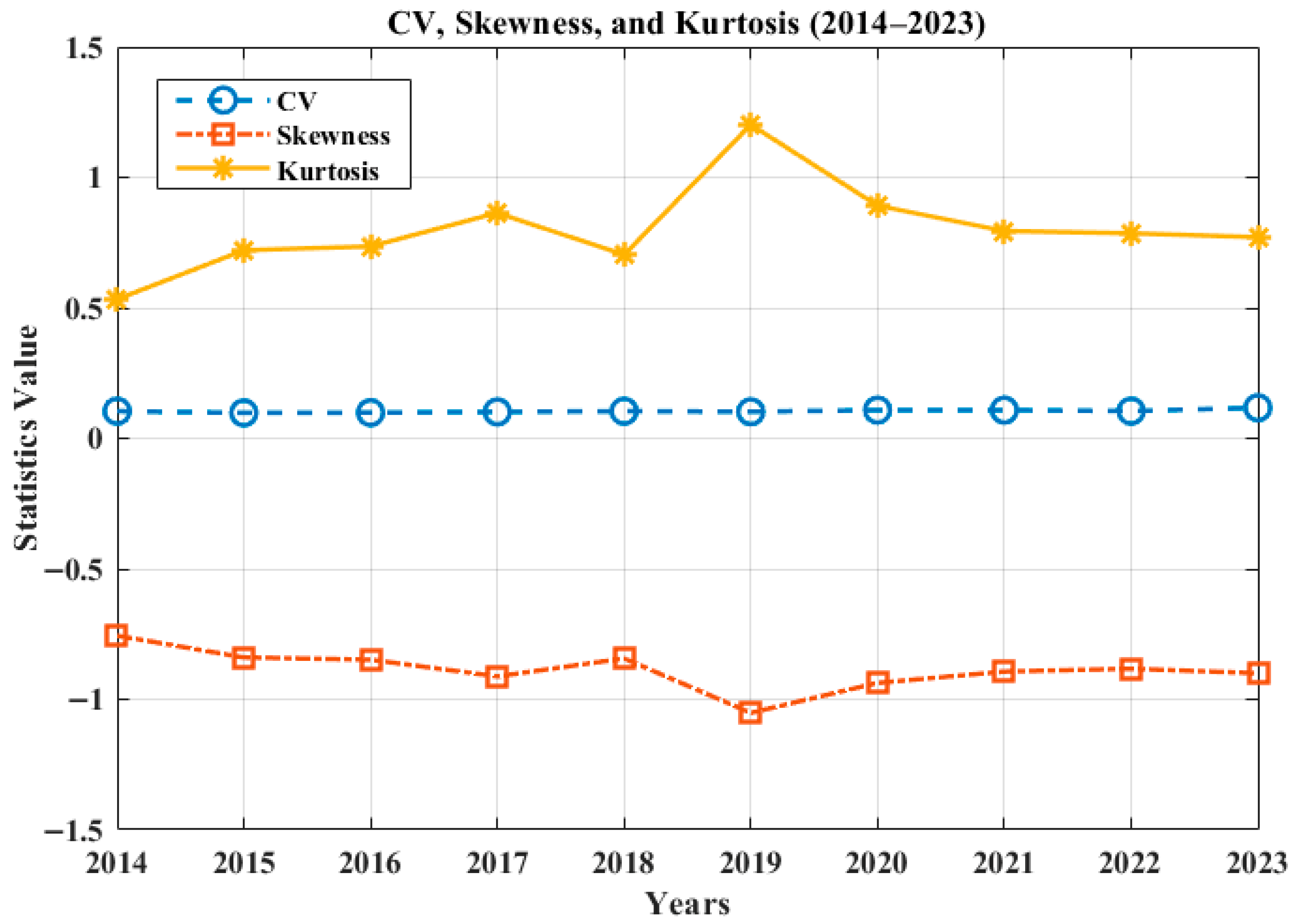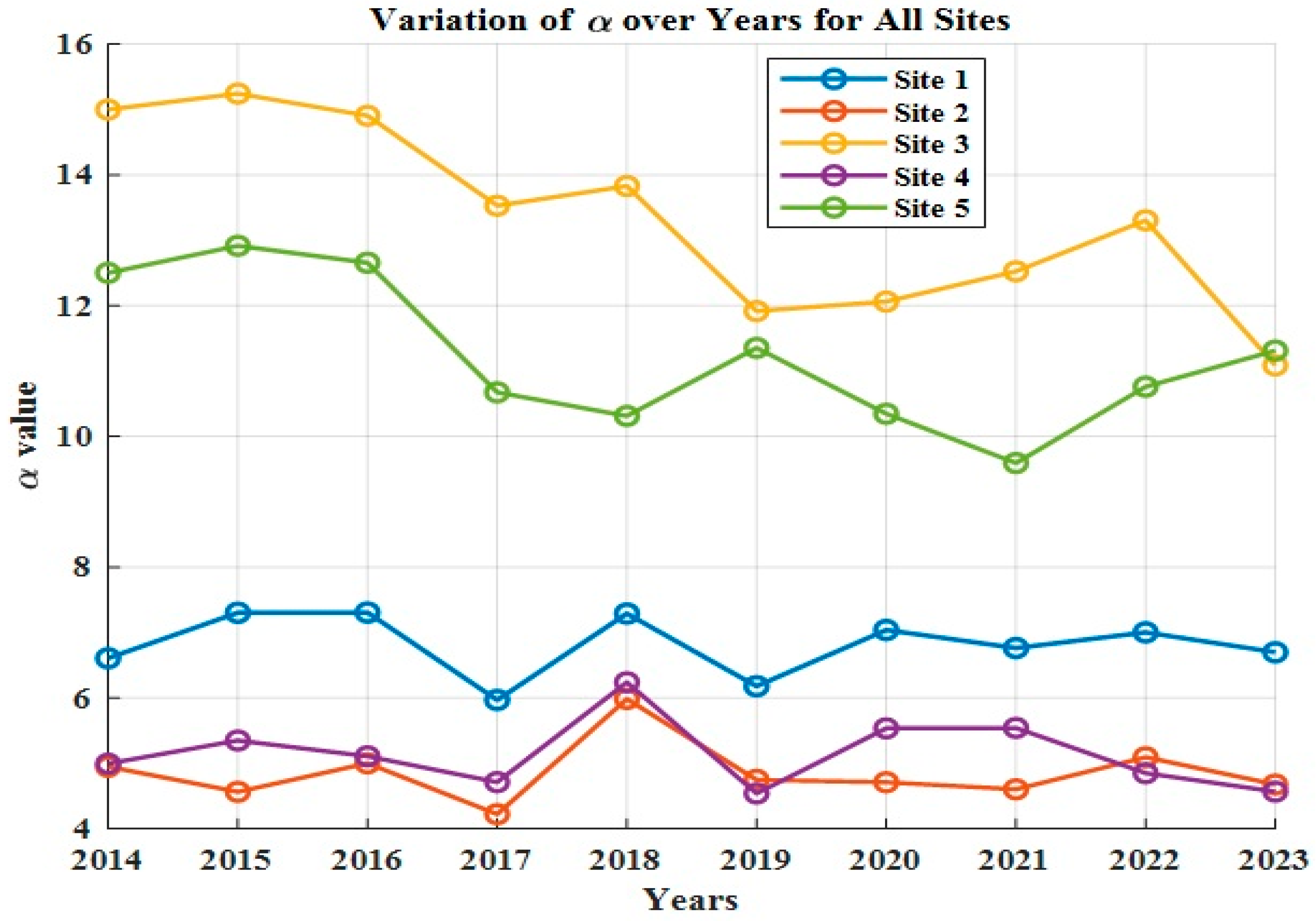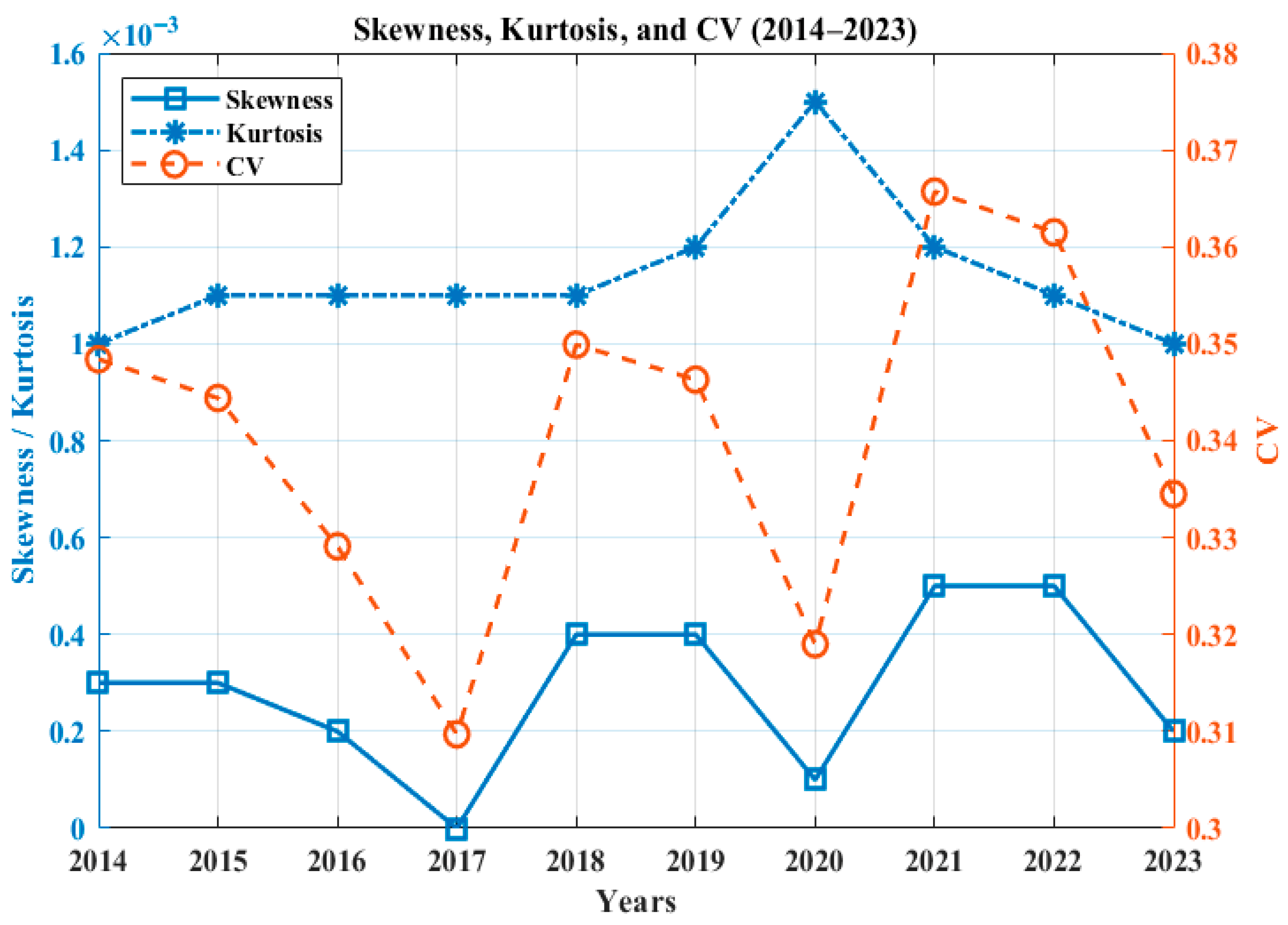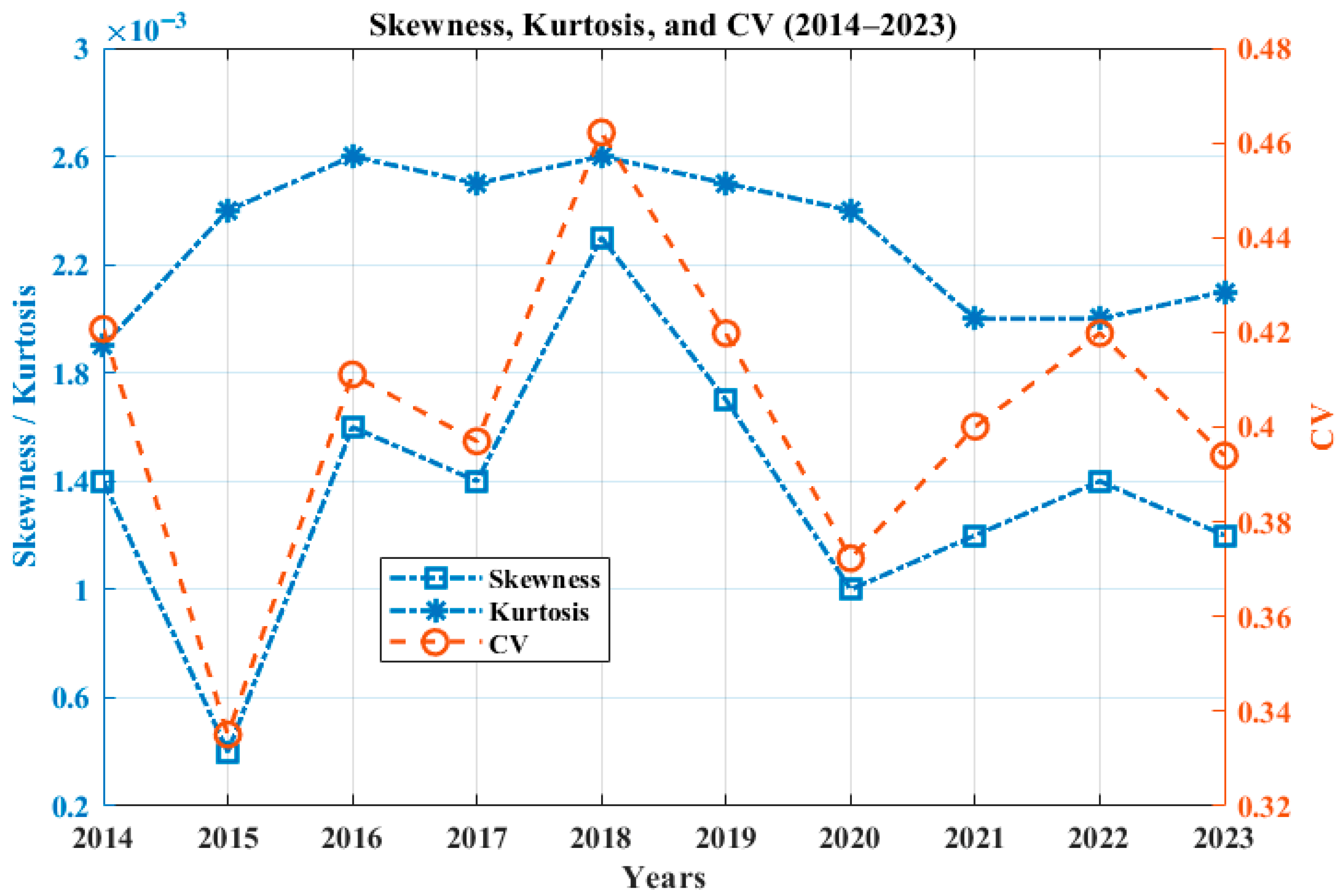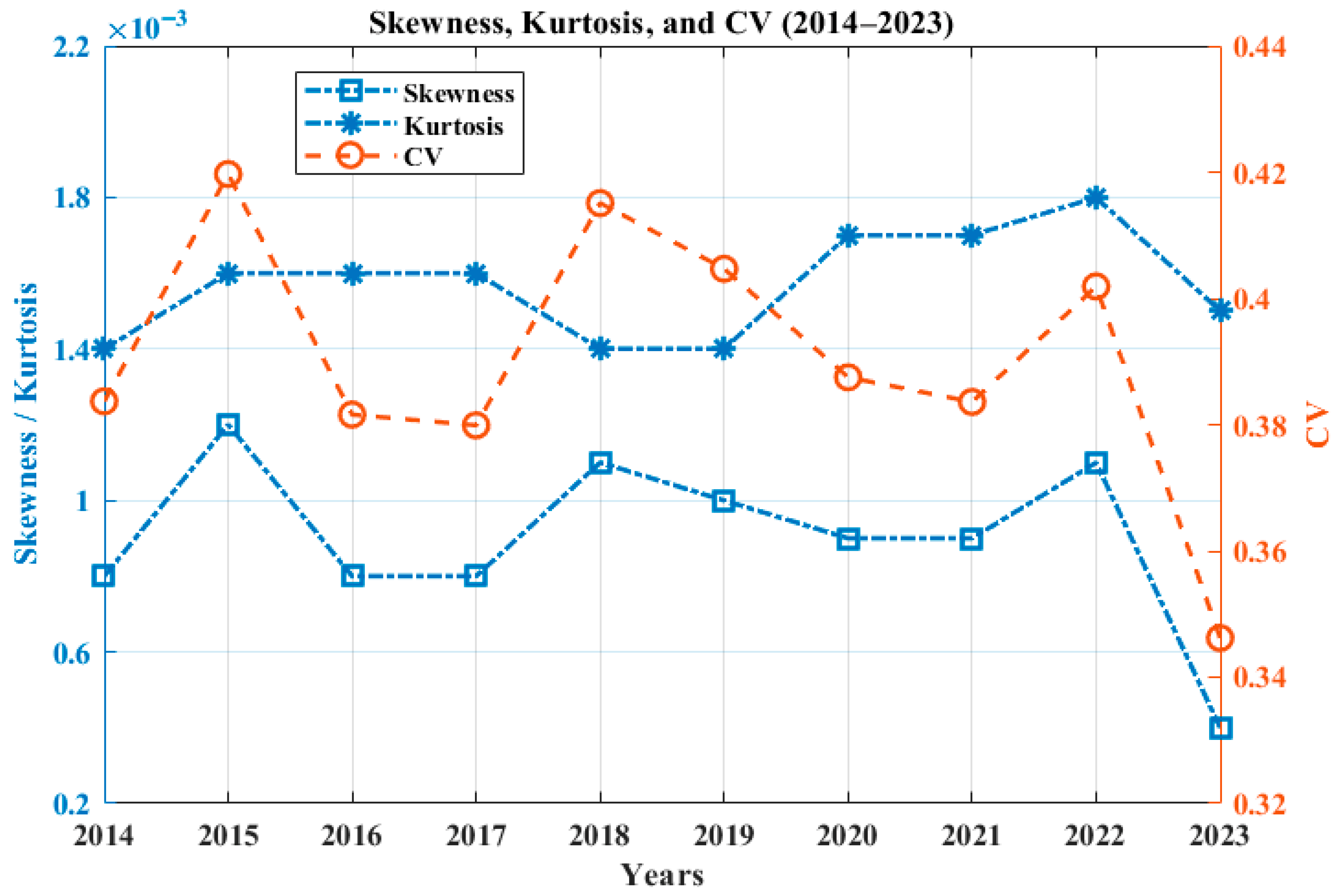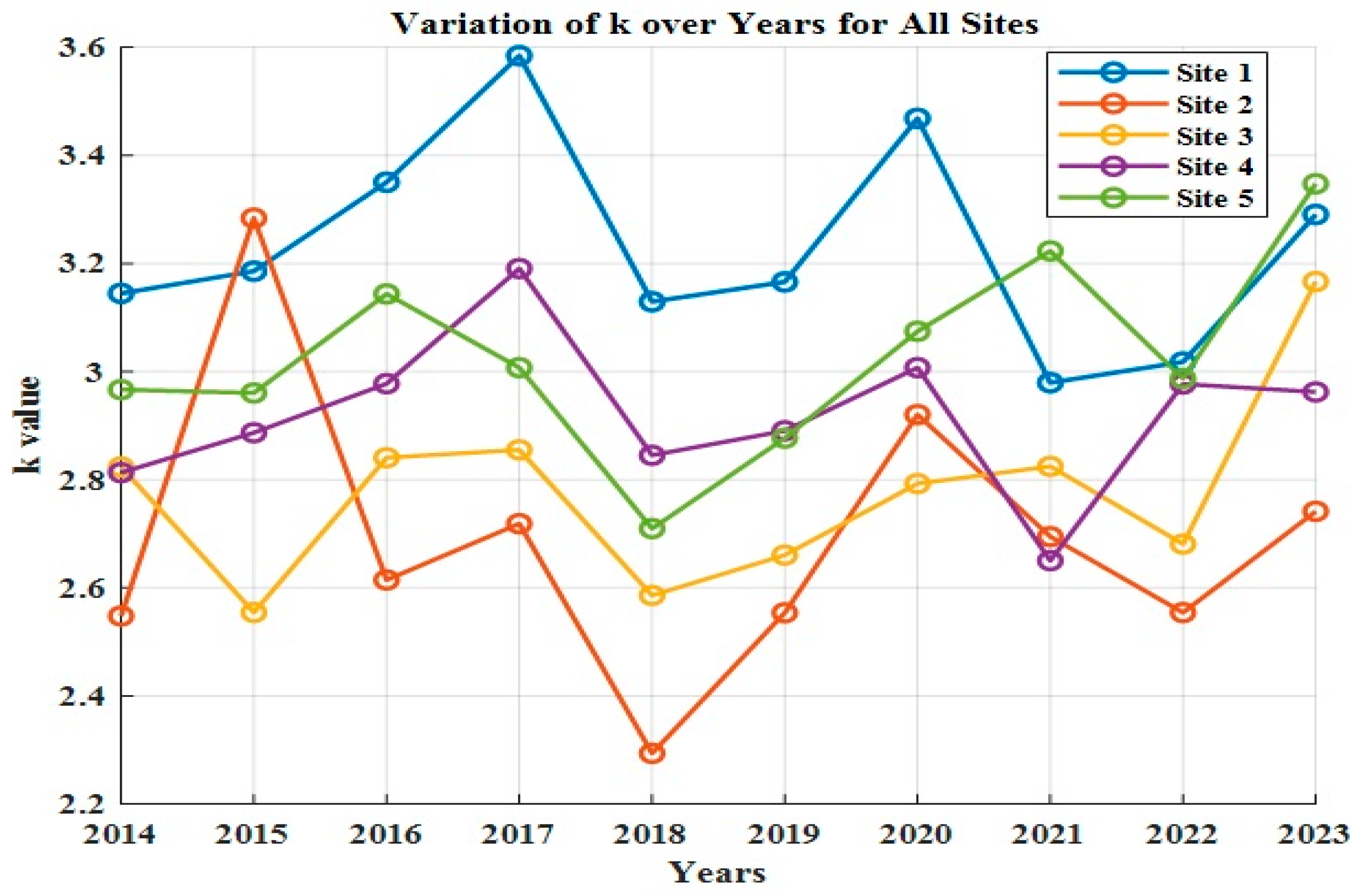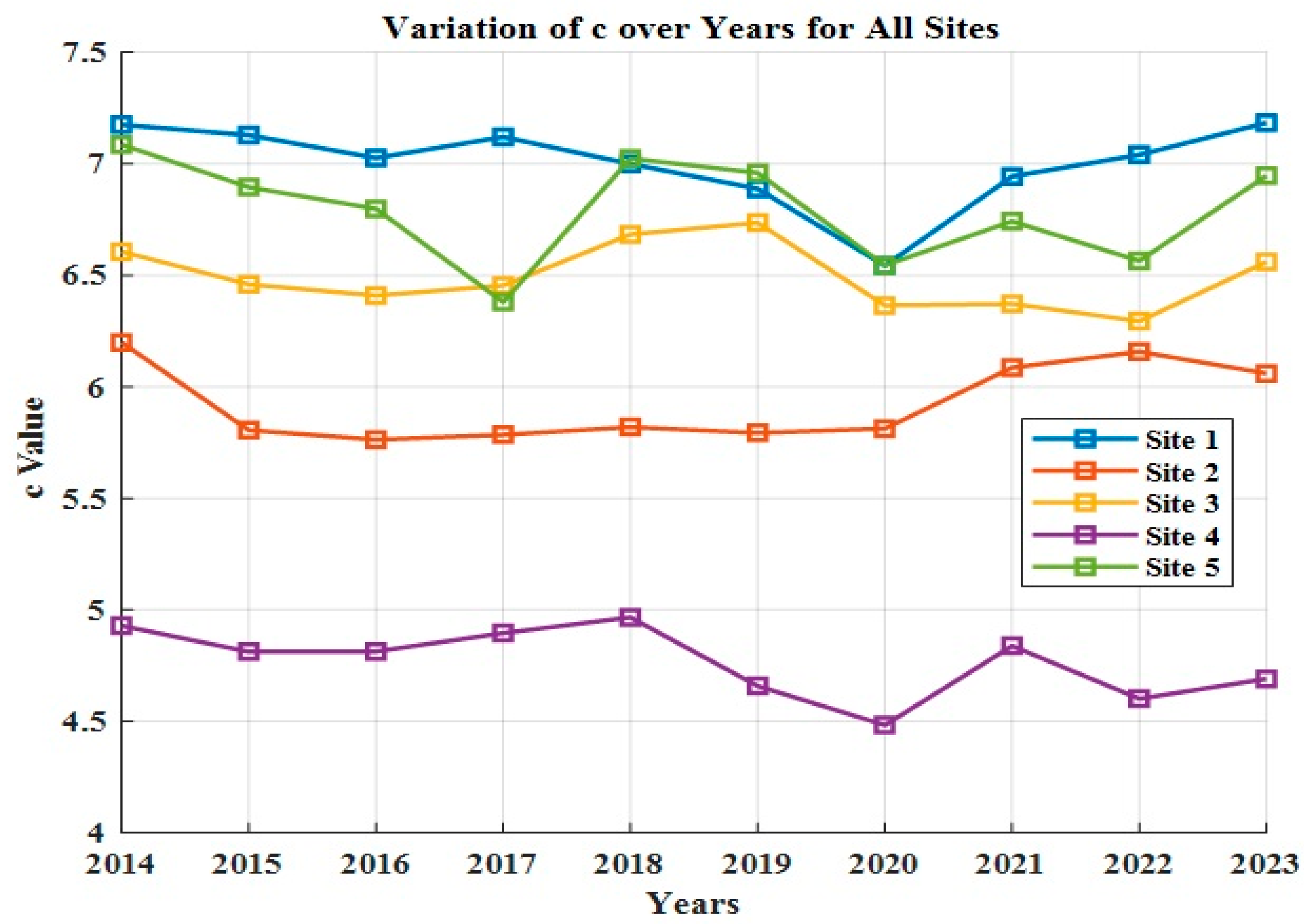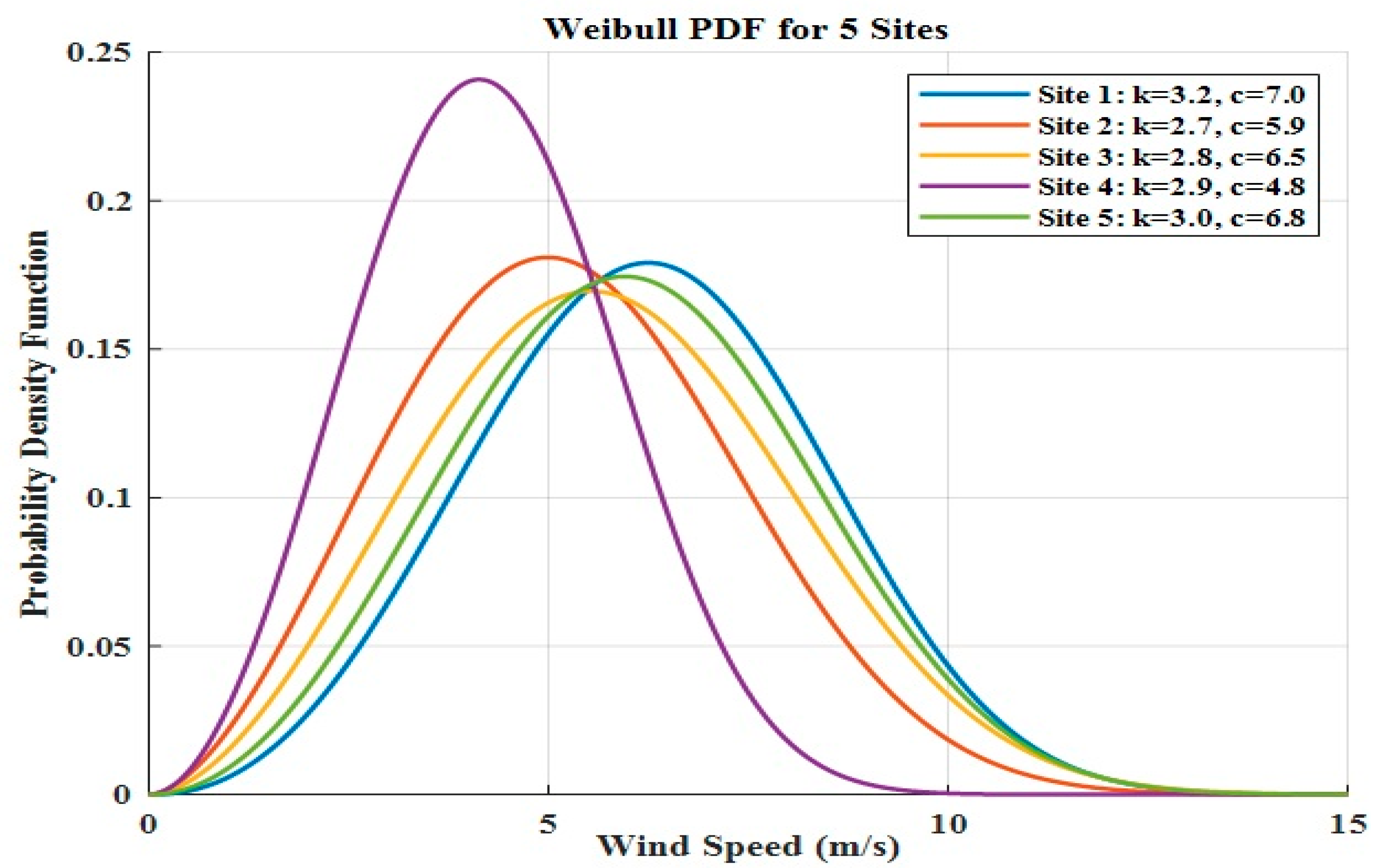1. Introduction
The generation of electrical power from renewable energy sources has become a reasonable aim, owing to their non-polluting nature and carbon-free emissions. Currently, worldwide communities need reliable and cost-effective power generation to meet their energy demands with the most affordable options. India holds enormous potential for renewable power generation, especially from solar and wind energy, due its significant size and various climatic circumstances. As the country is projected to experience an upsurge in electricity demand due to rapid industrialization and urbanization, India has set the ambitious target of producing energy from renewable energy resources. As per the report from the Ministry of New and Renewable Energy (MNRE), the country aims to achieve a capacity of 500 GW by 2030 from non-conventional sources, of which solar and wind are projected to be the foremost contributors [
1]. Thus, there is a need to identify the most feasible locations for the precise assessment of solar and wind energy potential. These evaluations of resource potential will facilitate system optimization, minimize financial risks, and ensure the long-term sustainability of renewable energy projects.
India receives annual average solar radiation of approximately 4–7
across latitudes 8°4′ and 37°6′ N, making it the most solar-rich country in the world, and most states in India have high exposure to wind due to their coastal proximity and wind flow regime [
2,
3]. Combining solar and wind energy supports standalone hybrid systems by reducing intermittency and improving grid stability through their complementary availability.
M. Sumair et al. [
4] assessed the feasibility of wind energy projects in southern Punjab, highlighting their role in promoting renewable energy and decreasing reliance on fossil fuels. The analysis used a two-parameter Weibull distribution with wind speed data from 11 locations across the region. Maisam Wahbah et al. [
5] introduced an innovative method that aimed to eradicate the bias that is generally found in traditional cross-validation procedures by probabilistically modeling the solar and wind energy sources crucial to renewable energy prediction and management. Lintong Liu et al. [
6] evaluated the performance of solar-, wind-, and hydrogen-based hybrid power systems using several analytical methods to measure system performance, attaining energy security and decreasing carbon discharges. Meskiana Boulahia et al. [
7] proposed a comprehensive engineering and statistical approach for solar examination to assess both geographical and technical potential. Madjid Chikh et al. [
8] conducted a qualitative and quantitative study in the Oran, which is located in Algeria and has limited solar potential, and estimated the precision of their model using statistical indicators such as mean bias error, root mean squared error, and t-statistics. Abdulkarim et al. [
9] performed frequency distribution analyses for solar and wind energy resources using various distribution functions. For solar radiation modeling, Weibull, Logistics, Lognormal, Beta, and Gamma were examined, and for wind speed modeling, Weibull, Rayleigh, and Gamma distribution functions were examined, respectively. After performing statistical tests like Kolmogorov–Smirnov, Anderson–Darling, and Chi-Square tests to judge the best-fitted distributions, it was observed that Beta is the most suitable for solar and Weibull is the best for wind potential investigations. C. Ojeda Avila et al. [
10] demonstrated the accuracy of the Angstrom–Prescott linear regression model and the Bird and Hulstrom approach in enhancing solar energy utilization across different conditions. Additionally, Weibull and Rayleigh distribution functions were employed to characterize wind resource variability. Vadim Manusov et al. [
11] assisted in analyzing the unpredictability of renewable energy sources, and suggested a practical explanation for refining the certainty of energy generation from wind and solar sources. D. H. Didane et al. [
12] used a two-parameter Weibull distribution to assess the wind characteristics of potential sites by examining the ten-year data from 2010 to 2019 in the Chittagong division of Bangladesh. Piotr Wais [
13] compared the three-parameter Weibull distribution function with the two-parameter function and found that the three-parameter distribution was better for wind speeds below 2 m/s with a high percentage of null winds. Amit Kumar Yadav et al. [
14] analyzed several statistical techniques to determine the parameters of the Weibull distributions for wind potential inspections at different sites in Andhra Pradesh. F. Youcef Ettoumi et al. [
15] highlighted the efficacy of Beta distribution for inspecting solar data in Algeria for the integration of solar energy in the future. M. Kolhe [
16] presented the solar radiation utilization in assessing system performance and enhancing strategy by developing the relationships between the photovoltaic array and battery capacity in standalone solar systems. Ihaddadene Razika et al. [
17] considered several distribution functions like Weibull, Gamma, Normal, Logistic, Lognormal, and Loglogistic functions to analyze the occurrence of solar irradiance; some statistical prediction parameters like correlation coefficient, root mean square error, mean bias error, and mean absolute bias error were evaluated to verify the efficacy of each model under investigation. M. Kolhe et al. [
18] designed a solar-powered motor system that works effectively in variable situations and analyzed the system’s working productivity, highlighting the importance of solar intensity and temperature on performance. A. Rathore et al. [
19] proposed a hybrid system based on the probabilistic modeling of solar and wind energy sources for which the author used Beta and Weibull distribution functions, respectively, to incorporate the intermittency along with pump storage hydro for reliability assessment. In reference [
20], the author indicated the optimal sizing and placement of solar and wind with gravity energy storage for enhancing system performance and reducing energy losses by improving the voltage profile.
The precise modeling of solar irradiance and wind speed is essential for the design, forecasting, and optimization of renewable energy systems. Based on the literature, the Beta distribution aligns well with normalized solar radiation data and effectively represents asymmetric and skewed patterns commonly observed across diverse geographical regions. It also offers greater flexibility, lower RMSE values, and superior statistical fitting compared with other distribution functions such as Normal, Gamma, and Lognormal distributions [
21]. For wind potential assessment, the Weibull distribution is preferred due to its greater adaptability relative to the Rayleigh distribution (which has a fixed shape), the Normal distribution (which is unsuitable for skewed wind data), and the Lognormal distribution (which is more complex and less stable). The Weibull distribution is widely chosen because it can represent a broad range of wind characteristics through adjustable shape and scale parameters and provides a direct analytical expression for wind power density (WPD) [
22,
23]. Therefore, among the various probability distribution functions, the Beta PDF (for solar irradiance) and the Weibull PDF (for wind speed) are recognized as the most effective, flexible, and practical choices for probabilistic renewable energy assessments.
The key objectives of this study include the following:
Assessing a long-term metrological dataset of renewable energy, i.e., solar (solar irradiance) and wind (wind speed) energy, from 2014 to 2023.
Conducting a probabilistic and statistical examination of solar and wind using Beta and Weibull PDF, respectively, to incorporate their intermittency.
Evaluating the prediction parameters to support the potential investigation of five locations.
Estimating supportive tests and parameters for fitting the distribution function for site analysis.
The individuality of this study encompasses three major aspects. First, the study utilizes a decade-long (2014–2023) high-resolution hourly dataset from Data Access Viewer v2.5.22 to evaluate both solar and wind resources simultaneously across geographically diverse Indian sites. Second, the study applies a probabilistic modeling framework combining Beta and Weibull distributions, enabling a statistically robust assessment of variability, reliability, and goodness-of-fit performance indicators (RMSE, MAPE, MBE, and K–S statistics). The simultaneous investigation of solar and wind has not been conducted previously in a probabilistic way in any of the reviewed studies. Third, the research decodes the statistical findings into engineering and planning insights by linking distribution parameters to wind power density (WPD) classes, maximum energy-carrying wind speeds (), and solar PV sizing implementations. These fundamentals collectively advance beyond previous regional studies that examined shorter time periods or focused on a single energy source, offering a more comprehensive framework for hybrid solar–wind site selection and system planning in the Indian context.
Figure 1 represents the incremental development in solar and wind power installed capacity for the last decade (2014-15 to 2023-24) in India [
3]. The total installed capacity from renewable sources (which includes wind, solar, small-hydro, and biomass power) was 143.65 GW as of 31 March 2024. The share of solar was 3.99 GW as of March 2015, which is approximately 9.97% of the total renewable capacity; this increased to 81.81 GW, which is almost 57% of the total renewable installed capacity. Similarly, wind capacity as of March 2015 was 23.44 GW (58.54% of total renewable capacity), which increased to 45.89 GW (31.95% of total renewable capacity). This represents a huge increment of 1950.30% for solar and 95.78% for wind from 2014 to 2024.
Figure 1.
Incremental growth of solar and wind capacity in India from 2014 to 2024 [
3].
Figure 1.
Incremental growth of solar and wind capacity in India from 2014 to 2024 [
3].
Figure 2 illustrates the renewable energy installed capacity of ten nations as of 31 December 2023 [
24]. China leads with the highest capacity of 1453.7 GW, whereas India has the fourth-largest installed capacity of renewable energy in world with 175.93 GW. These top ten countries contribute around 73.15% of the total global renewable capacity.
Figure 2.
Collective renewable energy installed capacity of 10 leading nations up to 31 December 2023 [
24].
Figure 2.
Collective renewable energy installed capacity of 10 leading nations up to 31 December 2023 [
24].
7. Result and Discussion
In this section, several parameters are assessed to determine the best potential site for solar and wind energy generation. The potential investigation for solar and wind is analyzed using the Beta and Weibull probability density functions, respectively. Five different locations in different states of India are investigated using a very large dataset for detailed and accurate trials. Hourly solar irradiance and wind speed data at a hub height of 50 m for each location were obtained from “Data Access Viewer” by the National Aeronautics and Space Administration (NASA) for the ten-year period of January 2014 to December 2023 for the assessment of each potential site under consideration.
7.1. Solar Potential Inspection Using Beta Distribution
Table 2 represents the annual mean statistical parameters for Kutch, Gujrat. The parameters include mean values for solar irradiance
, variance
, standard deviation
, mode
, coefficient of variation
, skewness
, and kurtosis
. Similarly,
Table 3,
Table 4,
Table 5 and
Table 6 represent the annual mean statistical parameters for Jaisalmer (Rajasthan), Davanagere (Karnataka), Rewa (Madhya Pradesh), and Anantapur (Andhra Pradesh), respectively.
Examining the statistical results from
Table 2,
Table 3,
Table 4,
Table 5 and
Table 6 shows that the maximum mean value of solar irradiance is found for Site 3: Davanagere with a per-unit value of 0.8666 for the year 2019, whereas the minimum value is 0.6985 for Site 4: Rewa for the year 2020. If the cumulative observation is taken for the complete observational study from 2014 to 2023, the maximum average solar irradiance value of 0.8456 remains the same for Site 3: Davanagere, whereas the minimum average value of 0.7238 is found for Site 2: Jaisalmer. The maximum average variance of 0.0260 is found for Site 2, while the lowest variance value of 0.0078 is found for Site 3. The average values for the whole assessment of mode for the most frequent solar irradiances are 0.8965 and 0.9057 for Site 3 and Site 5, respectively. Graphical representations of other statistics, like the coefficient of variation, skewness, and kurtosis, are shown below in
Figure 3,
Figure 4,
Figure 5,
Figure 6 and
Figure 7 for each respective site for better understanding.
The variation in coefficient of variation (CV), skewness (
), and kurtosis (
) across sites highlights distinct regional characteristics—higher skewness and CV values indicate greater resource variability, whereas lower kurtosis suggests a more stable energy potential. From
Figure 3,
Figure 4,
Figure 5,
Figure 6 and
Figure 7, it can be observed that the lowest CV value is 0.0976 for the year 2015 and the lowest average for the whole assessment period is 0.1046 for Site 3. However, Site 2 has a maximum CV of 0.2334 for the year 2023 and a maximum average of 0.2227. From all of the above observations presented tabularly and graphically, it can be observed that Site 3 is a more stable location for solar energy integration than the others due to its higher and more consistent mean solar irradiance with low variation in CV, skewness, and kurtosis.
A solar potential analysis was conducted using the Beta probability distribution function. Although several parameter estimation methods were discussed in
Section 1, the Maximum Likelihood method is preferred due to its high accuracy and its ability to handle the large hourly solar irradiance dataset collected over the assessment period. The annually estimated parameters for each site are presented in
Table 7,
Table 8,
Table 9,
Table 10 and
Table 11. Performance prediction indicators were evaluated alongside these parameters to validate the suitability of the selected PDF for potential site assessment. The indicators used include root mean square error (RMSE), mean absolute percentage error (MAPE), and mean bias error (MBE).
Table 6,
Table 7,
Table 8,
Table 9,
Table 10 and
Table 11 show that the average values of RMSE and MAPE for Sites 1–5 are 0.0317, 0.0362, 0.0399, 0.0340, and 0.0392 and 4.2829%, 4.8955%, 3.3384%, 5.4255%, and 3.6380%, respectively. The average for MBE for all sites is almost negligible, which is a good indicator of data fitting and potential locations. From these indicators, MAPE is still found to be best for Site 3 and the indicators are within the acceptable limits.
The annual variation in Beta parameters, that is,
and
, for all locations is shown in
Figure 8 and
Figure 9, respectively. The Beta distribution curve was drawn for all locations by taking the average value of
and
for the whole investigated period from 2014–2023; the findings are collectively represented in
Figure 10.
Next, the Kolmogorov–Smirnov fitness test (K-S test) was performed for all potential locations. The K-S statistics along with the
p-values are shown in
Table 10. For a null hypothesis to be accepted, the K-S value should be less than 0.05 with a
p-value greater than 0.01; the sample space for each site is considered as n = 87,600.
In
Table 12, the average values of the K-S statistics (also known as D-statistics or D-value) for the complete examination for Sites 1–5 are 0.0499, 0.0379, 0.0413, 0.0385, and 0.0462, respectively, and the
p-values are 0.4649, 0.6593, 0.5597, 0.6430, and 0.4642, respectively. The K-S statistics and
p-values for all sites are within the permissible range for testing the regularity for fitting, verifying that the assumed null hypothesis can be accepted for this solar potential study.
The outcomes of the Beta distribution parameters and associated performance indicators disclose consistent spatial and chronological patterns across the examined sites. The mean daily irradiance values, ranging from approximately 7.8 to 8.4 kWh·m−2·day−1, indicate that all five sites possess strong solar potential suitable for photovoltaic (PV) deployment. Among them, Site 2 exhibits the highest mean irradiance, suggesting greater energy yield potential, while Site 3 demonstrates the lowest coefficient of variation (CV ≈ 0.0078), indicating more stable solar conditions and reduced daily fluctuation.
The negative skewness and low kurtosis observed for Site 3 further confirm a near-symmetric distribution, signifying consistent irradiance availability with minimal extreme events or intermittency. This stability is also reflected in the lowest MAPE (3.34%) and RMSE (0.0399) values, suggesting that the fitted Beta model closely matches the observed irradiance data. In contrast, slightly higher CV and positive skewness values for Sites 1 and 5 point to higher variability caused by transient cloud cover and atmospheric disturbances typical of coastal and semi-arid regions.
Physically, these variations correspond to geographic influences—southern and central inland regions (e.g., Davanagere and Rewa) receive more uniformly distributed solar radiation, whereas western and coastal regions (e.g., Kutch, Jaisalmer) experience seasonal monsoon effects. From a planning perspective, the high mean irradiance of Site 2 makes it ideal for high-yield PV farms, while the exceptional stability of Site 3 is advantageous for hybrid system integration where predictable generation is essential for matching variable wind output.
7.2. Wind Potential Inspection Using Weibull Distribution
The data was collected from a hub height of 50 m in this investigation and can be extrapolated for different hub heights from the ground by means of the power law equation specified below.
where
= roughness factor and may vary for different geographical locations.
are the speed and height at respective locations.
Table 13 represents the annual mean statistical parameters for Kutch Gujrat. The parameters include mean values for wind speed
, variance
, standard deviation
, mode
, coefficient of variation
, skewness
, and kurtosis
. Similarly,
Table 14,
Table 15,
Table 16, and
Table 17 represent the annual mean statistical parameters for Jaisalmer (Rajasthan), Davanagere (Karnataka), Rewa (Madhya Pradesh), and Anantapur (Andhra Pradesh), respectively.
The statistics for the wind potential sites in
Table 13,
Table 14,
Table 15,
Table 16 and
Table 17 show that the maximum mean wind speed belongs to Site 1 at 6.4433
for the year 2023, with highest average value of 6.2271
for the whole assessment period. The lowest mean wind speed is found for Site 4 at 4.2537
. Similarly, the maximum average most frequent wind speed is also found for Site 1 at 6.2389
, which is represented by mode in this assessment. The maximum and minimum standard deviation and variance are found for Site 3 and Site 4, respectively. The other statistics—coefficient of variation, skewness, and kurtosis—are graphically illustrated in
Figure 11,
Figure 12,
Figure 13,
Figure 14 and
Figure 15 for each individual site.
The variation in CV, skewness, and kurtosis for all sites are shown in
Figure 11,
Figure 12,
Figure 13,
Figure 14 and
Figure 15. It can be seen that Site 1 has the average lowest CV of 0.3408 and the lowest skewness and kurtosis values of 0.0003 and 0.0011, respectively. The highest CV is found for Site 2, whereas highest average values for skewness and kurtosis are found for Site 4. The variation in statistics for all locations is within acceptable limits from the perspective of wind potential assessment, indicating that wind turbines can be used here for the generation of electricity. The best statistics are for Site 1, making it the best among the five investigated locations.
The wind potential assessment for the selected locations was conducted using the Weibull probability density function. Parameter estimation was performed using the Maximum Likelihood method due to its precision and ability to capture the intermittent characteristics of wind speed while efficiently handling the large dataset collected over the ten-year study period. The annually computed parameters for all locations are presented in
Table 18,
Table 19,
Table 20,
Table 21 and
Table 22. Performance prediction indicators are evaluated alongside these parameters to verify the suitability of the chosen PDF for assessing potential sites. The indicators used include root mean square error (RMSE), mean absolute percentage error (MAPE), and mean bias error (MBE).
Analyzing the performance indicators for all locations shows the lowest average RMSE of 0.0044 for Site 4 at 0.0001 for 2021, with the highest average for Site 3 at 0.0183 with 0.0362 for 2022. The lowest annual average MAPE of 0.1045 was found for Site 4 with a negative MBE, whereas the highest average value of 0.3173 was found for Site 3 at 0.6506 for 2022 and a positive MBE.
The yearly discrepancies of Weibull parameters, that, is
and
, for all sites are shown in
Figure 16 and
Figure 17, respectively. The Weibull distribution curve was drawn for all locations by taking the mean value of
and
for the entire inspected duration from 2014–2023, and it is jointly represented in
Figure 18.
Parameters such as wind power density and maximum energy-carrying wind were analyzed to enhance data accuracy and support the reliable selection of wind turbines for power generation. The average values for both parameters were evaluated for each location annually and are depicted in
Table 21. The highest average value of WPD was found for Site 1 at 205.48
with 222.04
for the year 2014, whereas the lowest range of WPD was found for Site 3. Similarly, the highest speeds corresponding to maximum power generation are shown in
Table 23.
The Weibull distribution examination illustrates differences in the wind behavior across the five sites. Sites 1 and 5 exhibit the highest average wind power densities (≈206 W/m2 and 197 W/m2, respectively) and higher maximum energy-carrying wind speeds (≈7 m/s), indicating favorable conditions for wind energy extraction. These results classify both sites under WPD Class 3 (fair resource), suitable for IEC Class II wind turbines. Conversely, Sites 2 and 3 show moderate WPD values (≈135–175 W/m2), which, while lower, still support small- or medium-scale turbine installations. Site 4, with WPD below 70 W/m2 and ≈ 4.7 m/s, represents a low-wind zone unsuitable for economic wind power generation.
The shape parameter k of the Weibull distribution reflects wind variability, with higher k values indicating more uniform wind speeds—such as those observed at Sites 1 and 5. This stability corresponds to their coastal or near-coastal exposure, where steady monsoon flows and sea-breeze circulation prevail. In contrast, lower k values at inland locations indicate sporadic gusts influenced by local terrain effects. Similarly, the scale parameter c, which is directly associated with the mean wind speed, further reinforces this spatial distinction: higher c values in coastal regions signify stronger and more energetic wind regimes.
From an engineering viewpoint, these findings indicate that Site 1 is best suited for dedicated wind energy generation or hybrid PV–wind configurations, while Site 3, despite lower WPD, offers stable operation that complements solar-rich conditions. The overall pattern illustrates a natural seasonal and spatial complementarity between high solar stability at inland locations and strong wind resources at coastal sites, strengthening the technical feasibility of hybrid system deployment.
When integrating solar and wind analyses, it becomes evident that resource complementarities exist both spatially and temporally. Coastal sites (Sites 1 and 5) show stronger winds during monsoon and nighttime periods, whereas inland sites (Sites 2 and 3) exhibit consistent daytime irradiance. This inverse correlation between solar and wind availability enhances hybrid reliability, reducing storage requirements and improving load-matching capability. Therefore, the combined use of Beta–Weibull probabilistic modeling not only provides accurate resource characterization, but also offers valuable insights for hybrid system configuration and planning across diverse Indian regions.
7.3. Model Validation and Goodness-of-Fit Assessment
To estimate the accuracy of the probabilistic models, the tailored Beta and Weibull distributions were compared with the observed frequency distributions of solar irradiance and wind speed, respectively. Illustrative annual statistical tests for solar (K-S statistics) and wind (WPD and ) verified the strong alignment between the observed and modeled probability density functions. Quantitatively, the low RMSE (<0.05), near-zero MBE, and non-significant K–S test results (p-value > 0.05) confirm that the estimated parameters (α, β) for Beta distribution and (k, c) for Weibull distributions satisfactorily reflect the underlying data. This authentication certifies the trustworthiness of the probabilistic framework for consequent site analysis and energy potential assessment.
7.4. Regional Comparison and Climatic Interpretation
The comparative analysis among the five sites highlights clear regional disparities. Coastal sites such as Kutch and Jaisalmer experience higher wind power density due to their exposure to strong periodic winds and lower terrain roughness. In contrast, inland and elevated sites like Rewa and Davanagere show smoother irradiance patterns and lower variability, attributable to more stable atmospheric conditions. The observed regional differences thus arise from a combination of geographic latitude, proximity to the coast, and monsoonal wind influence. Integrating these characteristics indicates that Site 3 offers superior solar stability, while Sites 1 and 5 exhibit stronger wind regimes—suggesting excellent complementarity for hybrid PV–wind system design.



